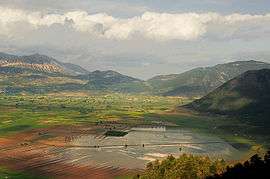Feneos
| Feneos Φενεός | |
|---|---|
|
Feneos plain showing seasonal floods. | |
 Feneos | |
|
Location within the regional unit  | |
| Coordinates: 37°57′N 22°19′E / 37.950°N 22.317°ECoordinates: 37°57′N 22°19′E / 37.950°N 22.317°E | |
| Country | Greece |
| Administrative region | Peloponnese |
| Regional unit | Corinthia |
| Municipality | Sikyona |
| Population (2001)[1] | |
| • Municipal unit | 2,359 |
| Community | |
| Time zone | EET (UTC+2) |
| • Summer (DST) | EEST (UTC+3) |
| Vehicle registration | ΚΡ |
Feneos (Greek: Φενεός, Latin: Pheneus) is a village and a former municipality in Corinthia, Peloponnese, Greece. Since the 2011 local government reform it is part of the municipality Sikyona, of which it is a municipal unit.[2] Its population was 2,359 in 2001. The seat of the municipality was in Goura.
In ancient times the area was considered part of the Arcadian region. According to Herodotus the river Styx originates near Feneos.[3] Feneos lies at the foot of Mount Cyllene, mythical birthplace of the god Hermes. It therefore served as an important cult centre for the god, notably during the annual festival of the Hermaea.[4]
In the Aeneid, Evander's fond memories of a visit by Aeneas' father Anchises to Feneos are one factor in his decision to ally his Arcadian colonists to the Trojans.[5]
References
- ↑ De Facto Population of Greece Population and Housing Census of March 18th, 2001 (PDF 39 MB). National Statistical Service of Greece. 2003.
- ↑ Kallikratis law Greece Ministry of Interior (Greek)
- ↑ Herodotus, Histories 6. 74. 1, http://www.theoi.com/Khthonios/PotamosStyx.html
- ↑ Pausanias (2nd century CE. Description of Greece. VIII: 14: 10.
- ↑ P. Vergilius Maro (29-19 BCE). Aeneis. VIII: 164.
| ||||||||||||||
